Developing a bespoke application can be a game-changer for businesses looking to tailor software solutions to their specific needs. Unlike off-the-shelf software, bespoke applications are crafted with unique features that align perfectly with your business processes. This article will guide you through the essentials of bespoke application development, providing you with a clear understanding of what it entails and how to embark on this journey.
The term "bespoke" originates from the tailoring industry, meaning custom-made. When applied to software, it refers to applications that are specifically designed and developed to meet the unique requirements of a particular client or business. Bespoke software application development is an approach that prioritizes customization, allowing companies to create solutions that address their specific operational challenges and enhance their efficiency.
Origins and Evolution of Bespoke Software
The concept of "bespoke" dates back to the tailoring industry, where garments were custom-made to fit an individual's unique measurements and preferences. Similarly, bespoke software is crafted from scratch to meet a business's specific needs, offering a high degree of customization that off-the-shelf solutions cannot provide.
This approach to software development has evolved over the years, with advancements in technology allowing for more sophisticated and tailored applications.
Key Characteristics of Bespoke Software
Bespoke software stands out due to its unique characteristics. It is tailor-made, meaning it is specifically designed to meet the precise needs of a business, offering a perfect fit for its processes and challenges. Additionally, bespoke software is scalable, allowing for adjustments as the business grows or changes. This flexibility is crucial for businesses operating in dynamic markets where adaptability is key to maintaining a competitive edge.
The Role of Customization in Business Efficiency
Customization is at the heart of bespoke software development and plays a vital role in enhancing business efficiency. By aligning software solutions with specific business processes, companies can streamline operations, reduce redundancies, and improve productivity. Customization also allows businesses to implement unique features and functionalities that can lead to innovation and a competitive advantage in the market.

Why Choose Bespoke Application Development?
Choosing to develop a bespoke application comes with numerous advantages. It offers a tailored fit to your business processes, providing flexibility and scalability that off-the-shelf solutions often lack. This customization can lead to improved productivity, as the software is built to support your unique workflows. Moreover, bespoke apps can offer a competitive edge, as they allow you to implement features and functionalities that are not available in standard software packages.
Tailored Fit to Business Processes
One of the most significant advantages of bespoke application development is its ability to provide a tailored fit to your business processes. Unlike generic software, which requires businesses to adapt their processes to the software, bespoke applications are built to accommodate existing workflows. This alignment ensures that the software supports and enhances business operations, leading to increased efficiency and productivity.
Flexibility and Scalability
Bespoke applications are inherently flexible and scalable, making them ideal for businesses that anticipate growth or changes in their operations. Because the software is custom-built, it can be easily adjusted to accommodate new requirements or expanded to include additional functionalities. This scalability ensures that the software remains relevant and useful as the business evolves over time.
Competitive Edge Through Unique Features
In today's competitive business landscape, having a unique selling proposition is crucial for success. Bespoke applications enable businesses to incorporate unique features and functionalities that are not available in off-the-shelf solutions. This customization can provide a competitive edge by allowing businesses to offer unique services, improve customer experiences, and differentiate themselves from competitors.
Steps to Develop a Bespoke Application
Embarking on a bespoke application development journey involves several key steps. Each stage requires careful consideration and collaboration between stakeholders to ensure the final product meets the desired objectives.
Step 1: Define Your Requirements
The first step in bespoke application software development is to clearly define your requirements. This involves a thorough analysis of your business processes and identifying the specific challenges you wish to address with the software. Engage with different departments within your organization to gather input and ensure that the application will cater to all relevant needs.
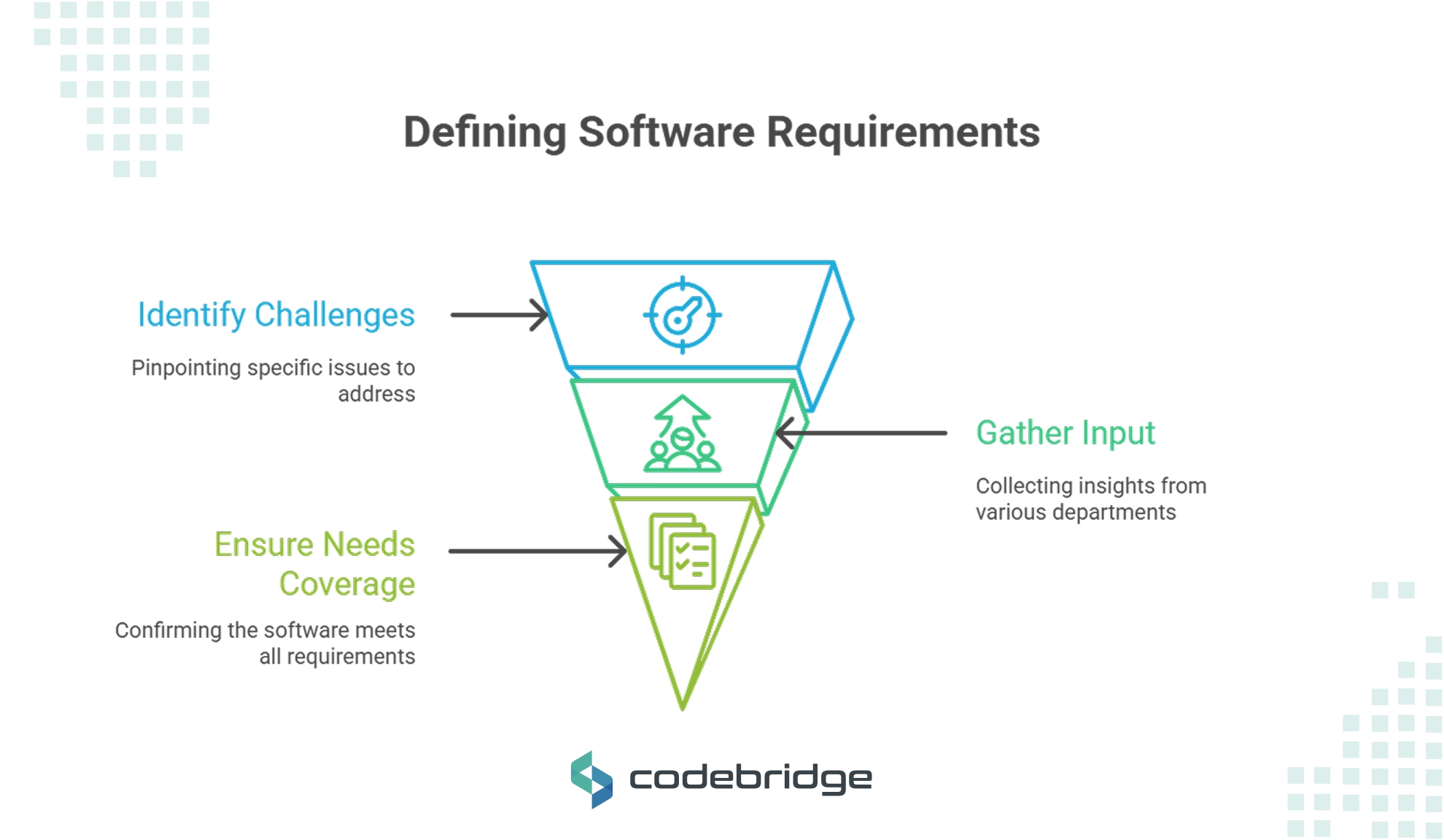
Conducting a Thorough Needs Analysis
Before you begin developing a bespoke application, it's crucial to conduct a thorough needs analysis. This process involves examining your current business processes, identifying pain points, and determining how a custom application can address these challenges. By involving various departments and stakeholders, you can gather valuable insights that will guide the development process and ensure the final product meets all necessary requirements.
Identifying Key Stakeholders
Identifying key stakeholders is an essential part of defining your requirements. Stakeholders can include department heads, end-users, IT personnel, and decision-makers. Their input is invaluable in understanding the specific needs of each department and ensuring that the application addresses the diverse requirements of your organization. Engaging stakeholders early in the process helps build consensus and ensures that everyone is aligned with the project's goals.
Prioritizing Features and Functionalities
Once you've identified your requirements and gathered input from stakeholders, it's important to prioritize the features and functionalities of the application. Not all features will have the same level of importance or urgency, so determining which elements are critical to the application's success is key. Prioritization helps guide the development process, ensuring that essential features are implemented first and that resources are allocated effectively.
Step 2: Choose the Right Development Partner
Selecting the right development partner is crucial for the success of your bespoke application. Look for a company with a proven track record in bespoke software development and a deep understanding of your industry. A good partner will work closely with you, offering insights and expertise to shape your ideas into a functional application.

Evaluating Potential Development Partners
When choosing a development partner, it's important to evaluate potential candidates thoroughly. Consider their experience in bespoke software development, their understanding of your industry, and their ability to deliver projects on time and within budget. Reviewing their portfolio and speaking with past clients can provide valuable insights into their capabilities and reliability.
Assessing Technical Expertise and Industry Knowledge
Technical expertise and industry knowledge are critical factors to consider when selecting a development partner. Ensure that the partner has a deep understanding of the technologies required for your project and is up-to-date with the latest industry trends. Their knowledge of your industry will enable them to provide valuable insights and recommendations that can enhance the development process and the final application.
Building a Collaborative Relationship
A successful bespoke application development project relies on a strong collaborative relationship between you and your development partner. Open communication, mutual respect, and a shared vision are essential for ensuring that the project progresses smoothly and that any challenges are addressed promptly. A good development partner will work closely with you throughout the process, providing regular updates and involving you in key decisions.
Step 3: Plan and Design
Once you've selected a development partner, the planning and design phase begins. This involves creating detailed specifications and wireframes that outline the application's architecture and user interface. Collaboration during this phase is essential to ensure the design aligns with your vision and business objectives.
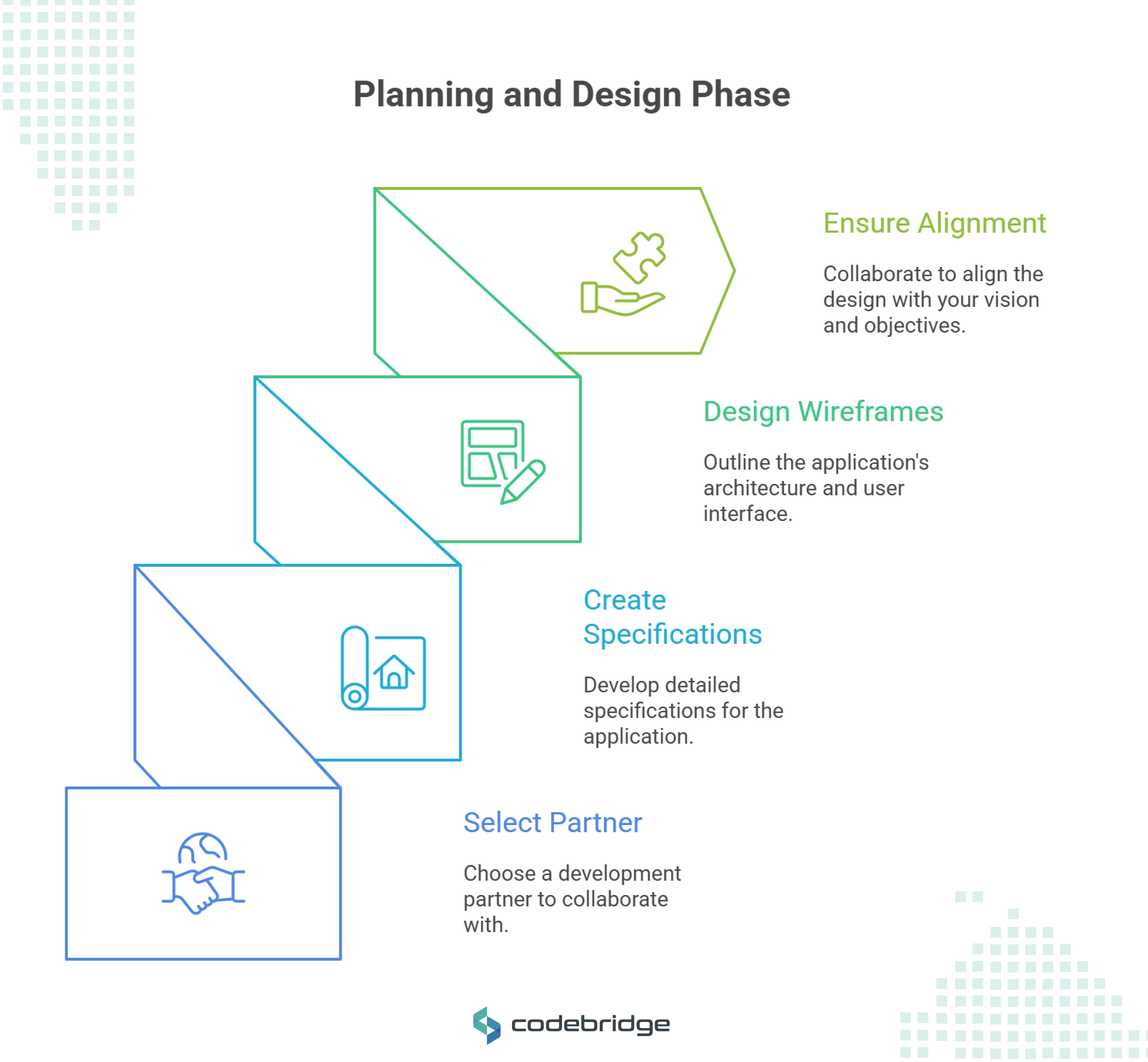
Creating Detailed Specifications
Detailed specifications serve as the blueprint for your bespoke application. They outline the application's architecture, features, and functionalities, providing a clear roadmap for the development team. Specifications should be comprehensive and detailed, covering all aspects of the application to ensure that the development process is streamlined and efficient.
Designing the User Interface and User Experience
The user interface (UI) and user experience (UX) design are critical components of the planning and design phase. A well-designed UI/UX ensures that the application is intuitive, easy to use, and visually appealing. Collaborating with your development partner on the design ensures that the application meets your business objectives and provides a positive experience for end-users.
Ensuring Alignment with Business Objectives
Throughout the planning and design phase, it's important to ensure that the application's design aligns with your business objectives. Regular collaboration with your development partner and stakeholders ensures that the application's architecture, features, and design support your business goals and address your specific challenges.
Step 4: Develop the Application
With the design in place, the development phase can commence. This is where your ideas come to life, as developers code the bespoke application according to the agreed specifications. Regular updates and communication with the development team are important to monitor progress and make any necessary adjustments.
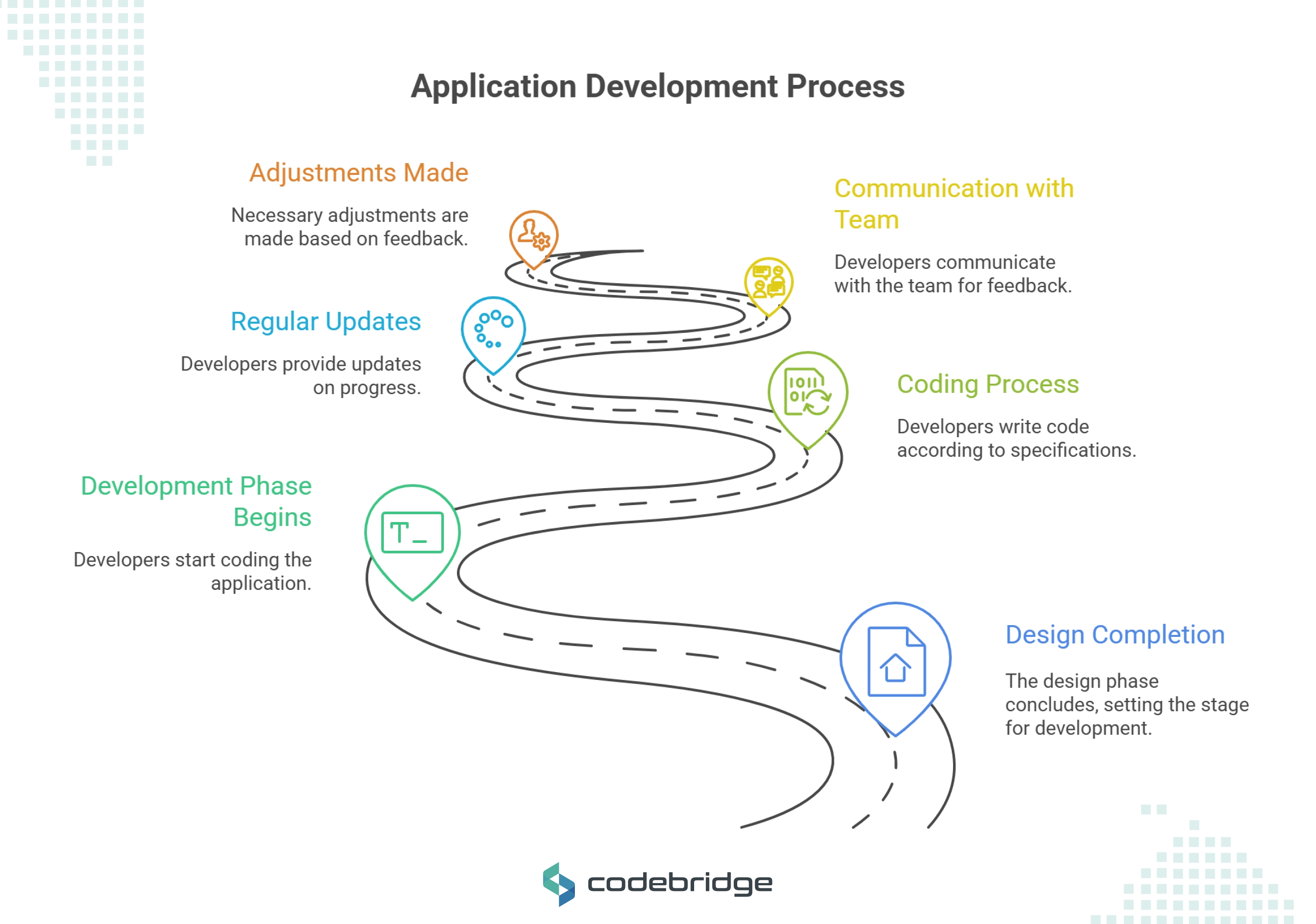
Coding and Development
During the development phase, developers bring your ideas to life by coding the application according to the agreed specifications. This process involves writing code, integrating various components, and building the application's features and functionalities. Regular updates and communication with your development team are crucial to ensure that the project stays on track and any necessary adjustments are made promptly.
Maintaining Communication and Collaboration
Effective communication and collaboration with your development team are essential throughout the development phase. Regular meetings, progress reports, and open communication channels help keep the project on track and ensure that any issues or challenges are addressed promptly. Maintaining a collaborative relationship with your development team helps ensure that the final product meets your expectations.
Addressing Challenges and Making Adjustments
During the development phase, challenges may arise that require adjustments to the original plan. Whether it's a technical issue, a change in requirements, or a new opportunity for improvement, being flexible and open to adjustments is key to the project's success. Working closely with your development team to address challenges and make necessary adjustments ensures that the final application meets your needs.
Step 5: Testing and Quality Assurance
Testing is a critical component of bespoke app development. It ensures that the application functions as expected and is free of bugs or errors. Quality assurance involves rigorous testing, including functional, performance, and security testing, to guarantee a robust and reliable application.
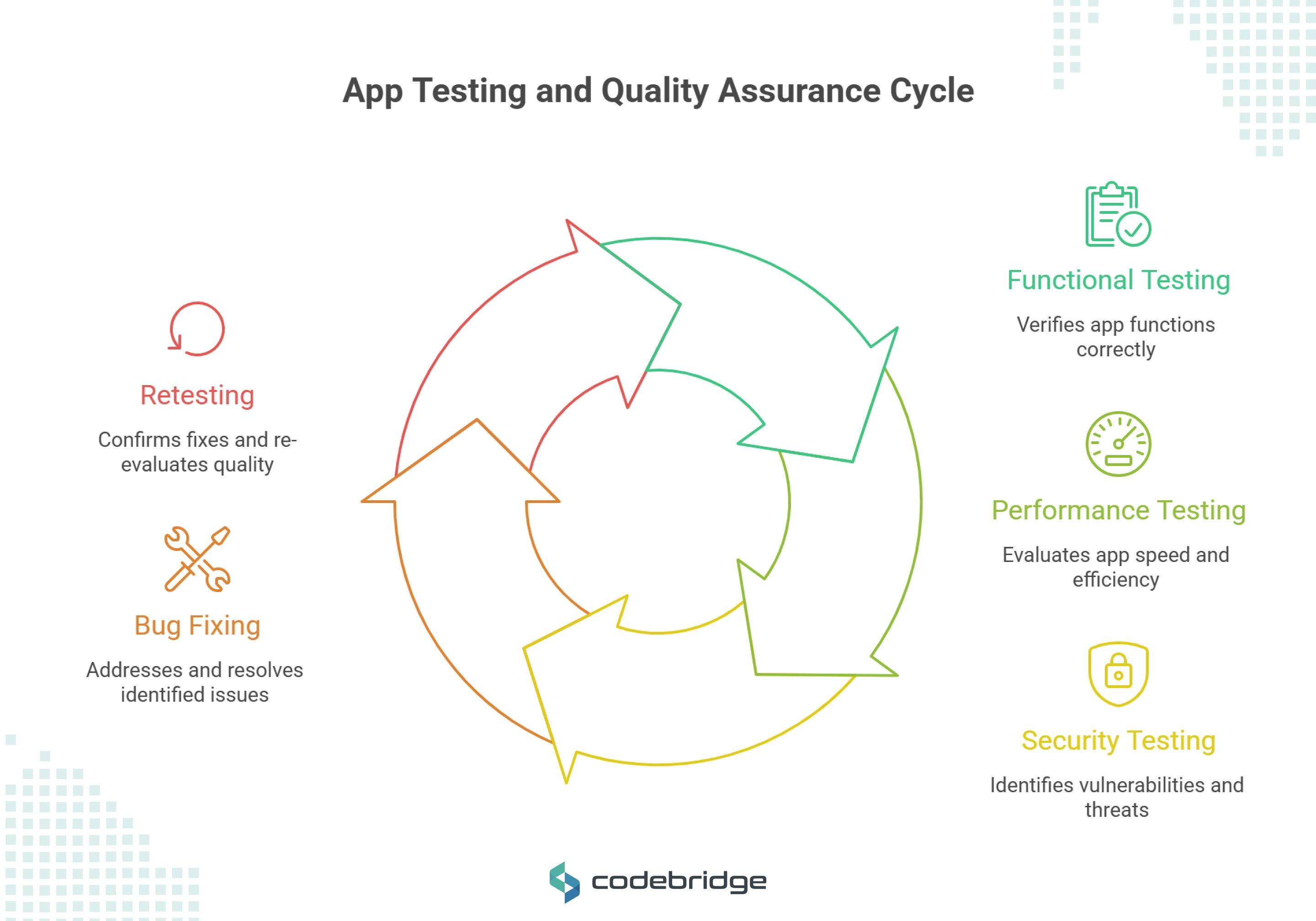
Conducting Functional Testing
Functional testing is an essential part of the quality assurance process. It involves verifying that each feature and functionality of the application works as intended. By testing the application against its specifications, you can ensure that it meets all requirements and performs as expected in various scenarios.
Performance and Security Testing
Performance and security testing are crucial to ensure that the application is robust and reliable. Performance testing evaluates the application's responsiveness, speed, and scalability, ensuring that it can handle expected loads and perform well under pressure. Security testing identifies vulnerabilities and ensures that the application is protected against potential threats, safeguarding your data and systems.
Ensuring a Reliable and Robust Application
The goal of testing and quality assurance is to ensure that the application is reliable, robust, and free of bugs or errors. By conducting thorough testing and addressing any issues that arise, you can ensure that the final product meets your expectations and provides a seamless experience for end-users.
Step 6: Deployment and Training
Once the bespoke application has passed all testing phases, it is ready for deployment. This involves installing the application in the production environment and ensuring it integrates seamlessly with existing systems. Training your team on how to use the new software is also vital for a smooth transition and to maximize the application's potential.
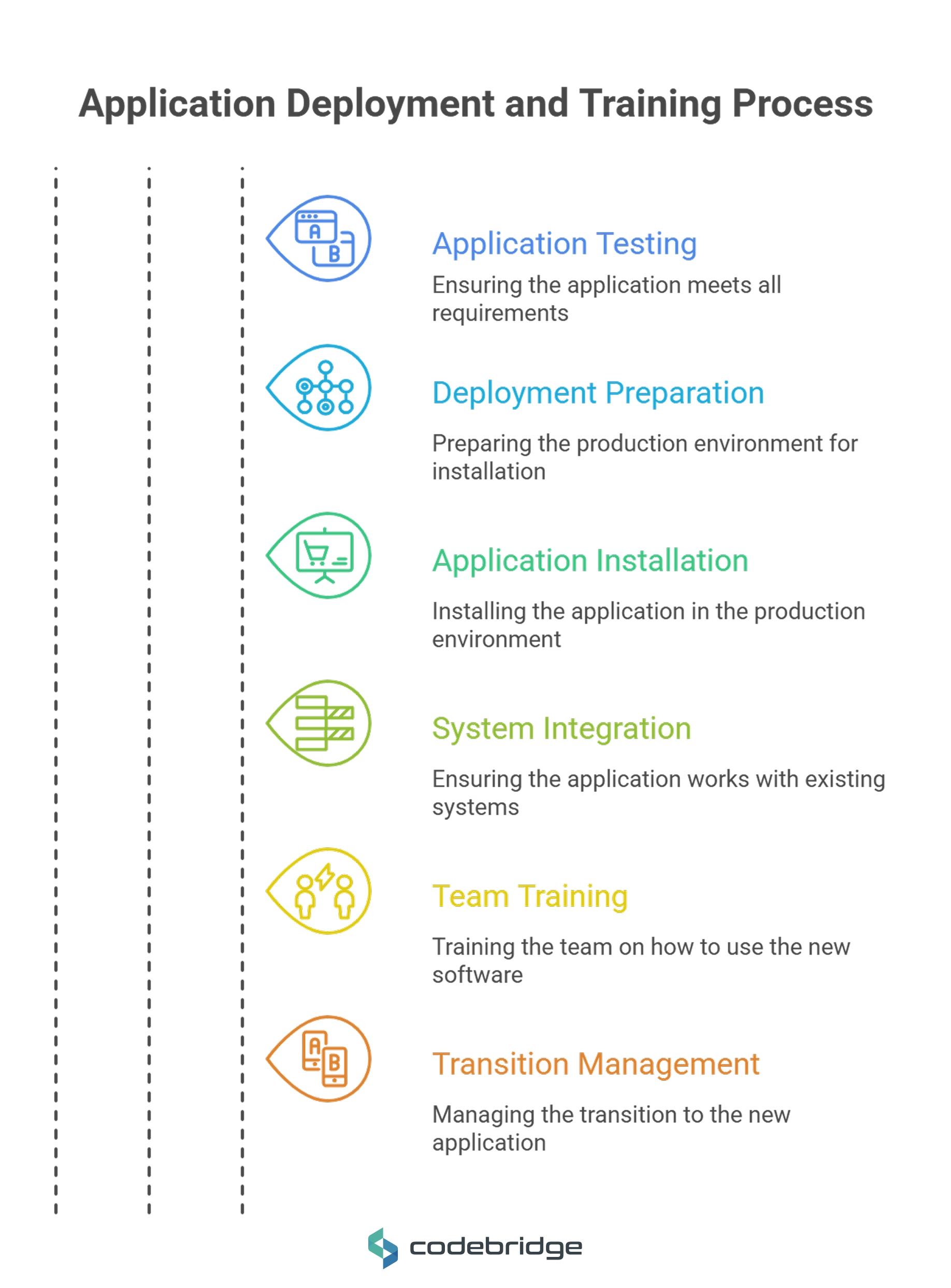
Preparing for Deployment
Preparing for deployment involves ensuring that the application is ready to be installed in the production environment. This process includes finalizing configurations, setting up necessary infrastructure, and conducting final checks to ensure that the application integrates seamlessly with existing systems. Proper preparation is key to a smooth and successful deployment.
Installing and Integrating the Application
The installation and integration of the application are critical steps in the deployment process. This involves setting up the application in the production environment, configuring it to work with existing systems, and ensuring that all components are functioning correctly. Successful integration ensures that the application operates seamlessly within your existing infrastructure.
Training Your Team
Training your team on how to use the new software is essential for a smooth transition and to maximize the application's potential. Provide comprehensive training sessions to ensure that all users are familiar with the application's features and functionalities. Well-trained users can leverage the software to its full potential, enhancing productivity and efficiency.
Step 7: Maintenance and Support
Bespoke software development doesn't end with deployment. Ongoing maintenance and support are necessary to keep the application running smoothly and to implement updates or improvements as needed. A reliable development partner will provide continuous support to address any issues and keep your software up to date.
Ongoing Maintenance and Updates
Ongoing maintenance is crucial to ensure that the application remains functional and up-to-date. This includes regular updates to address bugs, improve performance, and add new features as needed. A proactive approach to maintenance helps ensure that the application continues to meet your needs and supports your business objectives.
Providing Continuous Support
Continuous support from your development partner is essential for addressing any issues that arise after deployment. Whether it's troubleshooting technical problems, answering user questions, or providing additional training, reliable support ensures that your application continues to operate smoothly and effectively.
Adapting to Business Changes
As your business evolves, your application may need to be adapted to accommodate new requirements or changes in your operations. Regular communication with your development partner and a willingness to make necessary adjustments ensure that your application remains relevant and continues to support your business's growth and success.
Benefits of Bespoke Application Development
Bespoke application development offers numerous benefits that can significantly impact your business's success. These include:
- Customization: Tailored solutions that match your exact business processes and requirements.
- Scalability: Easily adaptable to accommodate growth and changes in your business.
- Competitive Advantage: Unique features and functionalities that set you apart from competitors.
- Efficiency: Streamlined processes that improve productivity and reduce operational costs.
- Integration: Seamless integration with existing systems and technologies.
.avif)
Customization and Tailored Solutions
Customization is one of the primary benefits of bespoke application development. Tailored solutions are designed to match your exact business processes and requirements, ensuring a perfect fit for your operations. This level of customization allows for greater flexibility and adaptability, enabling businesses to address specific challenges and enhance efficiency.
Scalability and Growth Potential
Bespoke applications are inherently scalable, making them ideal for businesses that anticipate growth or changes in their operations. As your business expands, the application can be easily adjusted to accommodate new requirements or expanded to include additional functionalities. This scalability ensures that the software remains relevant and useful as your business evolves.
Gaining a Competitive Advantage
In today's competitive business landscape, having a unique selling proposition is crucial for success. Bespoke applications enable businesses to incorporate unique features and functionalities that are not available in off-the-shelf solutions. This customization can provide a competitive edge by allowing businesses to offer unique services, improve customer experiences, and differentiate themselves from competitors.
Improving Efficiency and Reducing Costs
Bespoke applications streamline processes and improve efficiency by aligning software solutions with specific business processes. By reducing redundancies and automating tasks, businesses can increase productivity and reduce operational costs. This improved efficiency can lead to significant cost savings and a better bottom line.
Seamless Integration with Existing Systems
Bespoke applications can be seamlessly integrated with existing systems and technologies, ensuring that they work harmoniously within your current infrastructure. This integration helps streamline operations, reduce disruptions, and maximize the value of your existing investments.

Challenges and Considerations
While bespoke application development offers many advantages, there are also challenges to consider. These include the higher initial costs and longer development timelines compared to off-the-shelf solutions. However, the long-term benefits often outweigh these initial challenges, as bespoke software provides a return on investment through improved efficiency and business performance.
Higher Initial Costs and Investment
One of the primary challenges of bespoke application development is the higher initial costs compared to off-the-shelf solutions. Developing a custom application requires a significant investment of time, resources, and expertise. However, this investment can yield substantial returns in the long run through improved efficiency, productivity, and competitive advantage.
Longer Development Timelines
Bespoke application development typically involves longer development timelines compared to purchasing off-the-shelf software. The process of defining requirements, designing, developing, and testing a custom application takes time and careful planning. However, the result is a tailored solution that perfectly aligns with your business needs and offers greater long-term value.
Mitigating Risks and Challenges
While there are risks and challenges associated with bespoke application development, careful planning and execution can help mitigate these issues. By choosing the right development partner, conducting thorough needs analysis, and maintaining open communication, businesses can minimize risks and ensure a successful outcome.
Conclusion
Developing a bespoke application is a strategic decision that can transform the way your business operates. By following the outlined steps and working with a trusted development partner, you can create a software solution that is perfectly aligned with your business needs. Bespoke software development is an investment in your company's future, offering the flexibility, scalability, and competitive edge needed to thrive in today's dynamic market.
In conclusion, understanding the meaning of bespoke software and the process involved in developing a bespoke application is crucial for businesses looking to leverage technology to their advantage. With careful planning and execution, bespoke application development can be a powerful tool for driving growth and innovation in your organization. By embracing customization, scalability, and integration, businesses can unlock new opportunities and achieve lasting success.
Ready to Build a Solution Tailored to Your Business? Codebridge specializes in delivering bespoke software that fits your unique goals and scales with your growth.
Partner with experts who turn ideas into reliable, high-impact products.

FAQ
What is bespoke application development?
Bespoke application development is the process of creating custom-made software tailored to the unique needs of a specific business. Unlike off-the-shelf software, bespoke applications are built from scratch to match exact workflows, solve complex operational challenges, and support long-term business growth.
Why should a business choose bespoke software over off-the-shelf solutions?
Businesses choose bespoke software for its perfect process alignment, flexibility, scalability, and ability to include unique features not available in standard tools. This tailored approach improves efficiency, reduces manual work, integrates seamlessly with existing systems, and provides a long-term competitive edge.
What are the key steps involved in developing a bespoke application?
The bespoke development process includes defining requirements, choosing a qualified development partner, planning and designing the software, building the application, testing and quality assurance, deploying the solution, and providing ongoing maintenance. Each step ensures the software meets business goals and performs reliably.
How does customization improve business efficiency in bespoke applications?
Customization improves efficiency by aligning the software directly with existing workflows, eliminating unnecessary features, and automating manual tasks. This tailored approach reduces redundancies, increases productivity, and enables businesses to innovate faster with tools designed specifically for their operations.
What challenges should companies consider before investing in bespoke application development?
Companies should anticipate higher initial costs, longer development timelines, and the need for ongoing maintenance. However, these challenges are often outweighed by long-term benefits such as improved efficiency, scalability, competitive differentiation, and better alignment with business goals.
How does bespoke software support long-term scalability and business growth?
Bespoke software is built to evolve alongside the business. It can be expanded with new features, adapted for changing workflows, scaled to support more users, and integrated with new technologies. This flexibility ensures the application remains valuable and relevant as the organization grows.
Überschrift 1
Überschrift 2
Überschrift 3
Überschrift 4
Überschrift 5
Überschrift 6
Lorem ipsum dolor sit amet, consectetur adipiscing elit, sed do eiusmod tempor incididunt ut labore et dolore magna aliqua. Ut enim ad minim veniam, quis nostrud exercitation ullamco laboris nisi ut aliquip ex ea commodo consequat. Duis aute irure dolor in reprehenderit in voluptate velit esse cillum dolore eu fugiat nulla pariatur.
Zitat blockieren
Bestellte Liste
- Punkt 1
- Punkt 2
- Punkt 3
Ungeordnete Liste
- Artikel A
- Artikel B
- Punkt C
Fettgedruckter Text
Betonung
Hochgestellt
Index





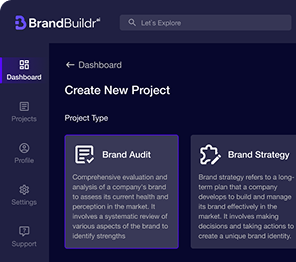
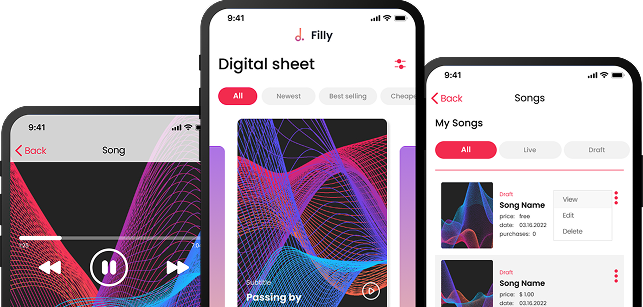










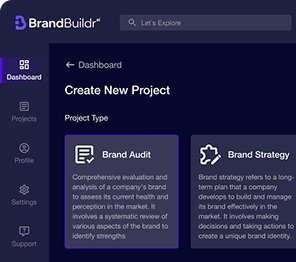
.avif)

.avif)






%20(3).png)
